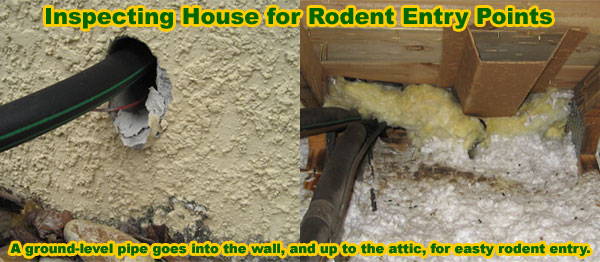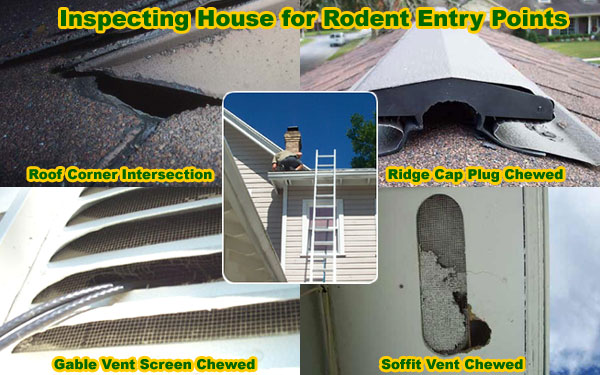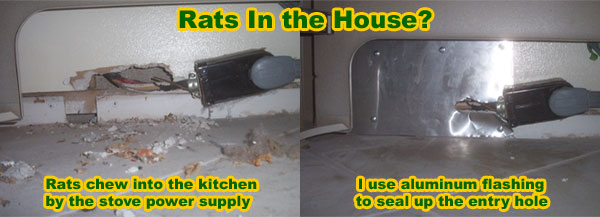- info@wildlife-removal.com
Call us for help in your town
Wildlife Removal Education
How are Rats Getting Into My House?
Need rat removal in your hometown? We service over 500 USA locations! Click here to hire us in your town and check prices - updated for year 2020.
This is the key to permanent rat control. You absolutely must find out how the rats are getting inside the building. If you don't discover this, and seal those areas shut permanently, then your
rat problem will never go away. It's essential that you fully inspect the building, every inch of it, and find all the rodent entry holes.
Knowledge of both rat behavior and building architecture is key. Rats can squeeze into amazingly small areas. Even rats that look very big can almost slide in like jelly into the tightest
of gaps and holes - it's amazing to watch. They can fit into a hole the size of a quarter, or a gap about 3/4 inch! How Big Do Rats Get?
They can inhabit very small nooks and crannies inside a house, from walls
to ceilings, crawl spaces and attics. They can enter homes so many ways - gable vents, eave gaps, ridge caps, crawl space vents at ground level, pipe entry holes, where electrical wires go in,
soffit vents, fascia boards, roof joints, AC chases, under loose siding, etc etc. They can chew their way in as well, of course, and that's what happens much of the time. What can Rats Chew Through?

Here's a photo of a very straightforward example - rats are able to easily enter a hole where an insulated pipe goes into an outer wall, up through the house, and into the attic. Notice the
trail of brown staining and droppings along the route in the attic.
So how do you find all of these areas? You inspect the building, very carefully. You have to look at every little nook and cranny. Sometimes, knowledge of rat signs helps - they leave brown grease
marks at entry points, if used often enough. But this isn't always visible. The entry holes are often where you don't expect them,
and you often have to crawl into tight spots and dig. Rats can also jump to areas you might not expect. Do Rats Jump? How High And How Far?
Use a heavy-powered light. Some houses or buildings are very
challenging. IT IS NOT EASY. It took me a long time, several dozen building inspections,
before I started to get good at it, and I made many mistakes during my first several rat jobs, and didn't solve my customer's problems. And I'm good! Experience really matters. Now I'm a seasoned
pro with many years and several hundred rat control jobs done, and it's still often a challenge.

You also want to do an attic inspection. Look for signs of rat damage inside the attic, such as chewed wires, droppings, trails in the insulation,
rat nests, burrows, tunnels, brown grease, chewed wood, chewed insulation on pipes, etc. This can help give a clue as to how many rats you have, and where they are travelling, and if you
follow the trails, you can figure out where they are coming in, sometimes.
How do you fix the holes then, and repair the home so that no more rodents can get in? I basically "rat-proof" the entire house, by sealing up all of these entry holes. This is the
best form of rat prevention available. I seal all holes with steel. Yes, you
have to use steel, because rats can chew through almost anything. They have very hard and sharp teeth, and can even chew through concrete if they want to! I use steel mesh, which I usually
bolt in. I also seal up the hole with a special polyurethane sealant. Sealing off the air flow helps a lot, because when rats detect air flow from inside a building, they work hard to chew
their way in.
And what if you have rats inside your home proper, like in your living room or kitchen? In that case, they found a way from the inner architecture, such as a wall or attic, into the house itself.
This is usually where there is some hole in the drywall, such as where pipes or power lines go through the wall. Check behind the stove, where the power supply goes into the wall, or behind the
washer and dryer. What to Do About Rats in the Home

Only after all of the holes have been sealed can you start the rat removal process. It's pointless to do so otherwise. I have some expert advice about
how to trap a rat, in which I advocate the use of snap traps, but only after the entry holes are sealed shut. My excellent how to get rid of rats
article also helps.
If you want to hire a professional to help with your rat problem, I recommend you go to my home page of Professional Rat Removal Companies to take care of the rodent
problem correctly. I absolutely do not recommend that you hire a regular pest control company for rat control work - they will cause more problems than help. Read more about How Long Does It Take For Rats to Breed in the Attic?
I will now address some of the more common questions that I receive about rats getting into a building:
How are rats getting into the attic - They most commonly enter via holes in the roof. However, they can also get into the attic from pretty much anywhere. They are small and can crawl around. If they get into the house from underneath, or from a ground-level opening, they can just scamper up the wall and into the attic. So the answer is: any opening into the house.
How are rats getting into the basement - Most usually from openings at ground level, such as ground vents. However, they can crawl into any hole, and down a wall, and into the basement or cellar.
How are rats getting into the building - Just read the above page, and you'll see many examples of entry points: gable vents, eave gaps, ridge caps, crawl space vents at ground level, pipe entry holes, where electrical wires go in, soffit vents, fascia boards, roof joints, AC chases, under loose siding, etc
How are rats getting into the barn - Not too hard - most barns aren't sealed terribly well. Gaps in the wood walls, the barn doors, etc.
How are rats getting into the car - Automobiles have a lot of gaps. The whole engine underside is open and exposed, of course. Rats can just crawl right into cars.
How are rats getting into the ceiling - They enter anywhere on the outside of the house, then crawl through the architecture and into the ceiling.
How are rats getting into the crawl space - Usually through ground-level vents, or if you have nothing at all blocking your crawl space, as is the case in many buildings, then they just waltz right on in!
How are rats getting into the garage - They most commonly get in the garage via the lower corners of the garage door, which usually are not sealed very tightly.
How are rats getting into the house - Rats get in the house via gaps and holes
outside.
How are rats getting into the home - They get into the living area of the home via gaps and holes in the drywall
How are rats getting into the kitchen - They get into the kitchen, usually where wires and ducts go through the wall, such as a vent, or the stove power supply. What Attracts Rats?
How are rats getting into the mobile home - The get into a trailer or mobile home
How are rats getting onto the roof - No problem! They can crawl any surface, and they get onto the roof as easily as you get onto the couch.
How are rats getting into the restaurant - Rats get into restaurants the same way they get into any other building - via open holes on the outside of the building.
How are rats getting into the shed - Most sheds aren't terribly well sealed, and clearly so of they can get into the shed easily.
How are rats getting into the walls - They get into walls very easily, as they can squirm though any tight spot in a building.
How are rats getting into the apartment or loft - Same as any other building.
How are rats getting into the oven - Stoves and ovens have gaps in the back, and I've removed dead rats from ovens many times over the years.
How are rats getting into the pantry - They can crawl very well. So long as the pantry is shut tight with no opening, they should not be able to get inside. So there must be an opening - either in the door, the base of the door, or a hole somewhere in the pantry or cabinet.
How are rats getting into the pipes - They can come up from the sewer, or street, or wherever the open end of the pipe is. So long as there isn't water in the pipe, it's a perfect rat tunnel!
How are rats getting into the toilet - The come up through the sewage pipes, of course. Without water, it's a cinch. With water, it's very unlikely.


















